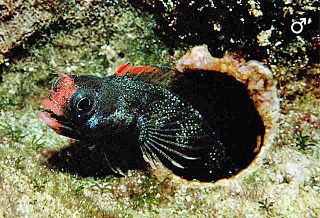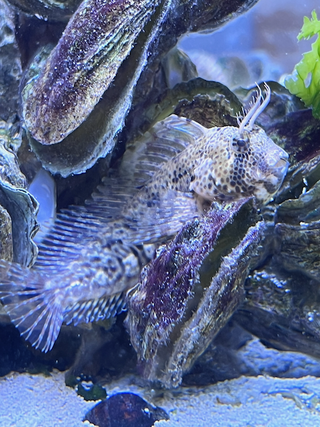
Combtooth blennies are blenniiformids; percomorph marine fish of the family Blenniidae, part of the order Blenniiformes. They are the largest family of blennies with around 401 known species in 58 genera. Combtooth blennies are found in tropical and subtropical waters in the Atlantic, Pacific and Indian Oceans; some species are also found in brackish and even freshwater environments.

The false cleanerfish is a species of combtooth blenny, a mimic that copies both the dance and appearance of Labroides dimidiatus, a similarly colored species of cleaner wrasse. It likely mimics that species to avoid predation, as well as to occasionally bite the fins of its victims rather than consume parasites. Most veiled attacks occur on juvenile fish, as adults that have been attacked in the past may avoid or even attack A. taeniatus.

Labrisomids are small blennioids (blennies), percomorph marine fish belonging to the family Labrisomidae. Found mostly in the tropical Atlantic and Pacific Ocean, the family contains about 110 species in 15 genera.

Blenny is a common name for many types of fish, including several families of percomorph marine, brackish, and some freshwater fish sharing similar morphology and behaviour. Six families are considered "true blennies", grouped under the order Blenniiformes; its members are referred to as blenniiformids. About 151 genera and nearly 900 species have been described within the order. The order was formerly classified as a suborder of the Perciformes but the 5th Edition of Fishes of the World divided the Perciformes into a number of new orders and the Blenniiformes were placed in the percomorph clade Ovalentaria alongside the such taxa as Cichliformes, Mugiliformes and Gobiesociformes.
Sabretooth or sabertooth may refer to:
Jean-Jacques Dussumier (1792–1883) was a French voyager and merchant from Bordeaux. He is known as a collector of zoological species from southern Asia and regions around the Indian Ocean between 1816 and 1840. These collections were later studied and classified by French zoologists such as Georges Cuvier, Achille Valenciennes, among others.

Salarias is a genus of combtooth blennies found in the Indian and Pacific oceans.

Ecsenius is a large genus of fish in the family Blenniidae. Several species, including Ecsenius midas, the Midas blenny, and Ecsenius bicolor, the bicolor blenny, are commonly sold at aquarium stores as pets.

Acanthemblemaria is a genus of chaenopsid blennies native to the Atlantic and Pacific Oceans.

Aspidontus dussumieri, the lance blenny or Dussumier's blenny, is a species of combtooth blenny found in coral reefs in the Pacific and Indian Oceans. The specific name honours the French explorer and merchant Jean-Jacques Dussumier (1792-1883).

Aspidontus tractus is a species of combtooth blenny found in coral reefs in the western Indian Ocean. It reaches the length of 10 centimetres (3.9 in) TL. It mimics Labroides dimidiatus, the cleaner wrasse, and feeds on the fins of fish that mistake it for the cleaner wrasse. Eggs are laid in clusters below the surface.

Cirripectes is a large genus of combtooth blennies found throughout the Pacific and Indian oceans. Cirripectes biconvexus, an otolith based fossil species from the Burdigalian (Miocene) of southwestern India is probably the earliest record of this genus.
Striped blenny is a common name for several fishes and may refer to:

Hypleurochilus is a genus of combtooth blennies found throughout the Atlantic Ocean.

Hypsoblennius is a genus of combtooth blennies found in the Pacific and Atlantic Oceans.

Meiacanthus is a genus of combtooth blennies found in the western Pacific and Indian oceans. Many species in this genus make their way into the aquarium trade and several are venomous. The genus name Meiacanthus is derived from the Greek meion meaning "less" and akantha meaning "thorn" and refers to most species having relatively few dorsal fin spines.

Parablennius is a diverse genus of combtooth blennies found in the Atlantic, western Pacific, and Indian Ocean.
Emblemaria is a genus of chaenopsid blennies found throughout the Pacific and Atlantic oceans.

Starksia is a genus of labrisomid blennies native to the western Atlantic Ocean and the eastern Pacific Ocean. Their typical length is 2 cm (0.79 in) SL. The generic name honours the American ichthyologist Edwin Chapin Starks (1867-1932) of Stanford University for his work on Pacific coastal fishes. As a genus Starksia is distinguished from other labrisomids by their scaled bodies, two obvious soft rays in the pelvic fin and the male's have an intromittent organ which is near to or attached to the first spine of their anal fins, which is also somewhat separated from the fin.

Blenniinae is one of two subfamilies in the combtooth blenny family Blenniidae, it is the smallest of the two subfamilies in the Blennidae with 16 genera and 95 species.
















